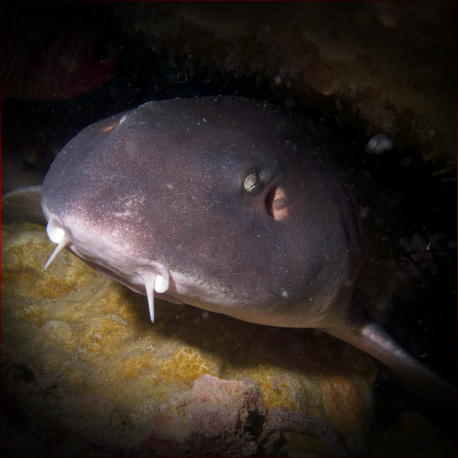More info
Datasheet
| Minimum Tank Size | 1360 litres / 359.27 US gallons |
| Maximum Size | 15.2cm / 5.98inches |
| Reef Compatible | No |
| Temperament | Aggressive |
| Care Description | Expert Only |
| Specific Gravity | 1.020-1.025 |
| Carbonate Hardness | 8-12 |
| pH | 8.1-8.4 |
General Description
The Black Banded Cat Shark, scientifically known as Chiloscyllium punctatum, earned its moniker due to the cat-like barbels near its mouth, resembling whiskers. Its cream-colored body is adorned with broad, dark black stripes, occasionally interspersed with large, muted brown spots as it matures. As part of the Hemiscyllidae family, this species typically grows up to 15.2cm in length.
Aquarium Suitability
Exclusively recommended for experienced aquarists, the Black Banded Cat Shark demands specialized care and an environment that mimics its natural habitat. Its carnivorous diet and aggressive temperament necessitate a minimum tank size of 1360 liters, with sand substrate to avoid scratching its delicate abdomen, prone to infections. Copper-based medications should be strictly avoided, as they can be harmful to the shark.
Demands, Care, and Hardiness
Known for its challenging care requirements, the Black Banded Cat Shark requires a well-maintained environment with stable water conditions. Ideally kept in a species-specific setup due to its aggressive nature, providing hiding spots and ample swimming space is crucial for its well-being. Regular monitoring of water parameters, including a pH of 8.1-8.4, alkalinity of 8-12 dKH, and salinity of 1.020-1.025, is essential for its health.
Reef Suitability
With a temperament that leans towards aggression and a carnivorous diet, the Black Banded Cat Shark is not compatible with reef environments. Its predatory behavior and specific dietary needs make it unsuitable for cohabitation with delicate reef organisms.
Aquarium Setup
Creating an optimal aquarium setup for the Black Banded Cat Shark involves providing ample space for swimming and bottom-dwelling areas. A tank of at least 1360 liters, equipped with sand substrate, caves, and potential hiding spots, is necessary for its comfort. Ensuring proper filtration and regular water changes are essential to maintain pristine water quality.
Behaviour
Typically a bottom-dweller, the Black Banded Cat Shark displays territorial and aggressive behavior, especially towards tank mates. Due to its carnivorous nature, it may show predatory tendencies, particularly towards smaller fish or invertebrates. Providing a well-structured environment with suitable hiding spots can help mitigate potential aggression.
Feeding and Diet
Feeding the Black Banded Cat Shark can be initially challenging, requiring a varied diet of high-quality foods. Introducing small pieces of cleaned squid or live saltwater feeder shrimp can entice the shark to eat. Subsequently, offering a diet of shrimp, scallops, fresh marine fish, whole cockle in the shell, fresh shrimp, squid, and frozen mussel is recommended to ensure its nutritional needs are met.
Dimorphism and Captive Reproduction
Dimorphism in the Black Banded Cat Shark is not prominently documented. Captive reproduction of this species is rare and challenging, making it uncommon in home aquariums. Further research is needed to fully understand the reproductive behavior and success rate of breeding this species in captivity.
Habitat and Distribution
The Black Banded Cat Shark is commonly found in the home aquarium trade, originating from the waters of the Indo-Pacific region. Its natural habitat includes tropical coastal waters where it frequents coral reefs and sandy areas, exhibiting a preference for the ocean floor. Understanding its natural habitat and behavior is crucial for successfully maintaining this species in captivity.

